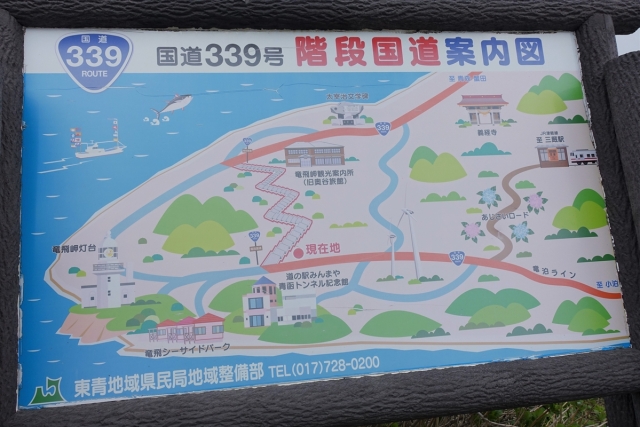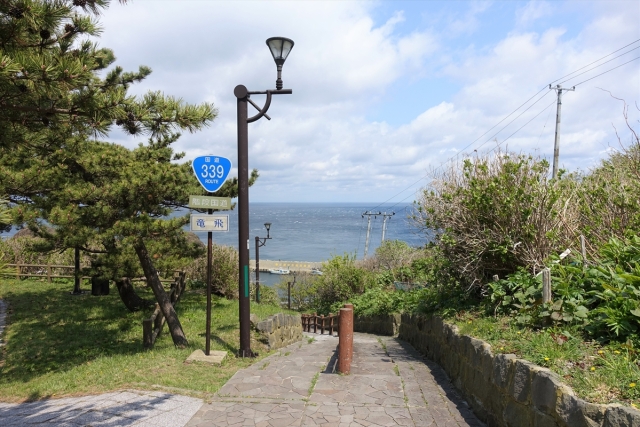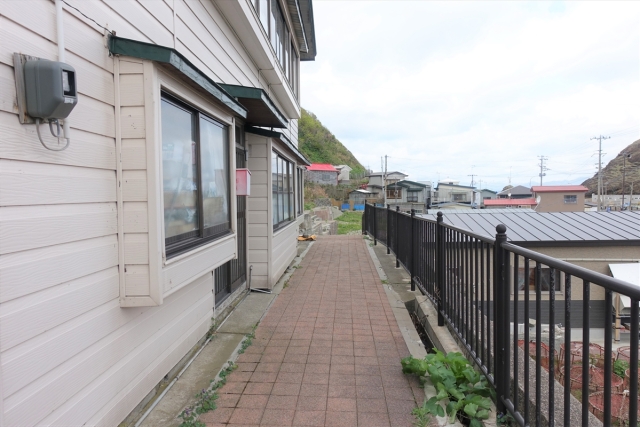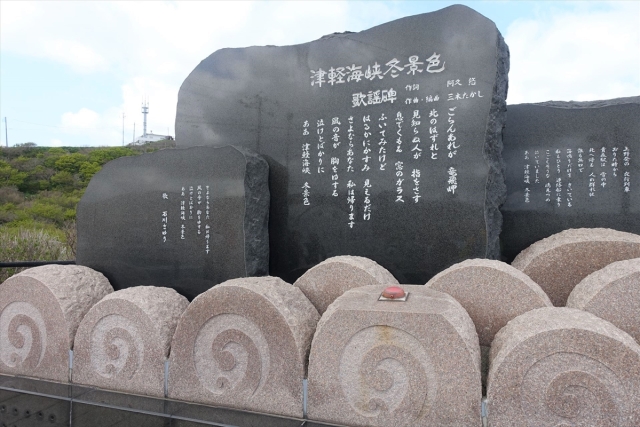
An unusual hidden tourist site for the intrepid traveller.
While a lot of overseas visitors to Japan spend most of their time exploring famous cities like Tokyo and Kyoto, there’s a whole country outside of these sites that’s well worth exploring.
Take Tsugaru-gun in Aomori Prefecture, for example. This is where you’ll find the famous Cape Tappi, which juts out into the Tsugaru Strait at one of the northernmost tips of the mainland. It’s a rugged, windy spot that inspired a famous enka entitled “Tsugaru Kaikyo Fuyugeshiki” (“Tsugaru Strait Winter Scene”), which became the signature song for the hugely successful singer Sayuri Ishikawa.
▼ Cape Tappi
The views from Cape Tappi are spectacular — on clear days like this one, you can see the island of Hokkaido on the horizon across the Tsugaru Strait.
There are a lot of remote tourist sites in this region, which locals like to keep to themselves, and one of them is the “Staircase National Highway“.
▼ The sign here reads “Kaidan Kokudou”, which translates to “Staircase National Highway”.
This is the only spot in Japan where a national highway becomes a set of stairs. While the triangular sign for highway number 339 appears just as it does on the nearby roads, no bikes or vehicles can access this particular section of the highway, because it’s home to a long stretch of stone steps.
Originally, this was a road used as a school route for the elementary and junior high schools located at the middle and top of the road. The stairs from the middle to the top of the road were constructed after it was designated as a national highway.
Following the highway designation, which came about in 1974, the road for vehicular access became divided into north and south sections. There is a steep cliff between the two roads at this point, making it difficult to build a road between the sections, so the stairs were built to provide access to this part of the national highway.
▼ Japan’s Highway 339, marked in red, includes the zigzag of stairs.
Now that the schools are gone, the stair highway remains as a tourist destination. When our reporter Haruka Takagi visited the area recently, she saw many people taking commemorative photos in front of the unusual highway sign at the top of the stairs.
The starting point had a scenic view and a fresh sea breeze, which inspired Haruka to walk the length of the stairs. As soon as she descended down a few steps, she was surrounded by trees and greenery.
▼ There’s no way you could describe this as a typical national highway. It was more like hiking in the mountains.
Haruka was filled with energy as she strode down the stairs, but she became a little concerned about the journey ahead when she saw people pass her on the ascent. They were visibly out of breath, with their hands on their knees as they appeared to be struggling with the uphill return.
She decided to worry about the ascent later, enjoying this part of the journey while she could. It didn’t take long for her to arrive at the mid-point of the stair highway, which opened up a little to resemble a small square, with a stone monument taking pride of place.
▼ The monument reads: “Minmaya Village Tappi Junior High School Site“
With the school now demolished, there appeared to be a new building set up in its place, which looked more like a community centre or public hall.
This was certainly a tranquil spot for a school, and it must’ve been a tiny one, given the plot of land here. Haruka could almost hear the students laughing and chatting as she gazed out at the beautiful view they would’ve enjoyed so many years ago.
From this point, every step down took Haruka closer to the sea, until she was able to clearly see the boats and locals going about their daily business. It was such a beautiful day that Haruka marvelled at the blueness of the Tsugaru Strait, which she had always thought was black, due to the rugged nature of the weather when she’d previously seen it.
Only about half a minute after she left the school site, Haruka cottoned on to the reason why people on the ascent appeared to be so exhausted.
This section zigzagged relentlessly, making for a tough climb. Upon seeing the stairs, Haruka’s mind stepped in to question whether she really needed to complete the journey, but she silenced it with a determination that she hoped wouldn’t bite her in the rear afterwards.
After passing the zigzag section, Haruka thought that was the end of the surprises, but that’s when the highway took another unexpected turn, leading her…
▼ …past the front door of someone’s house!
If someone were to say they lived along a national highway, you’d expect it to be filled with noise and traffic, but this definitely wasn’t the case here. The width of the road soon became narrower as well, stretching about a metre (3.2 feet) across and looking more like a path than a highway.
Now Haruka was down at sea level, at the end of the staircase highway and at the point where it meets up with the usual stretch of route 339.
Haruka had counted 362 steps on her descent, and now she had to go back and climb them.
▼ A daunting prospect.
It may not look that difficult in the photos but according to Haruka, the stairs are incredibly steep and that’s what makes it so draining on the body. After all, you have to bear in mind that this is a cliff that nobody could build a road on, so every step was arduous.
▼ Haruka stopped for a breather a few times on her way back up the stairs
Thirsty and sweaty, Haruka persevered until she finally managed to return to the top of the stairs.
Feeling triumphant, Haruka was pleased to say she’d walked the only stair highway in Japan, and she highly recommends everyone give it a try at least once, although you should bear in mind that the stairs aren’t cleared of snow in winter.
While you’re in the area, Haruka also recommends visiting the cape, where you’ll find a large monument displaying the lyrics of the “Tsugaru Strait Winter Scene” enka…
▼…and a button that blasts out the enka when pressed.
▼ It’s gusty here, though, so remember to hold on to your hat!
There are plenty of other fantastic places to visit in Aomori, including destinations where you can view a unique set of Pokémon manhole covers, and seven more places locals want to keep to themselves. It’s a region well worth adding to your itinerary once Japan opens up to tourists again. Happy travels, everyone!
Photos ©SoraNews24
● Want to hear about SoraNews24’s latest articles as soon as they’re published? Follow us on Facebook and Twitter!
[ Read in Japanese ]





















 National Highway 339: The only staircase highway in Japan
National Highway 339: The only staircase highway in Japan In search of Japan’s biggest tanuki, we stumble across something equally big
In search of Japan’s biggest tanuki, we stumble across something equally big Japan’s northernmost brewery on the mainland is…a temple?!?
Japan’s northernmost brewery on the mainland is…a temple?!? Travel off the beaten path to a secret spot in Japan where bamboo grows wild on an old train line
Travel off the beaten path to a secret spot in Japan where bamboo grows wild on an old train line Ramen restaurant’s English menu prices are nearly double its Japanese ones, denies discriminating
Ramen restaurant’s English menu prices are nearly double its Japanese ones, denies discriminating Here’s what our bachelor writers ate over the New Year’s holiday in Japan
Here’s what our bachelor writers ate over the New Year’s holiday in Japan That time Seiji called JASRAC to ask why he didn’t get paid royalties for his song being on TV
That time Seiji called JASRAC to ask why he didn’t get paid royalties for his song being on TV The Purple Lucky Bag from Village Vanguard is an extra-large waste of money
The Purple Lucky Bag from Village Vanguard is an extra-large waste of money The top 10 haunted spots in Japan as chosen by a professional ghost chaser
The top 10 haunted spots in Japan as chosen by a professional ghost chaser Japanese beauty trends of the 20th & 21st centuries, and predicting future fashions
Japanese beauty trends of the 20th & 21st centuries, and predicting future fashions Private booths are coming to Japan’s Shinkansen bullet trains even sooner than we’d thought【Video】
Private booths are coming to Japan’s Shinkansen bullet trains even sooner than we’d thought【Video】 Japanese beef bowl chain Sukiya’s 2026 Smile Box lucky bag basically pays for itself
Japanese beef bowl chain Sukiya’s 2026 Smile Box lucky bag basically pays for itself Rakuten randomly offers 58 New Year’s osechi feasts in Japan, but did we get a star or a dud?
Rakuten randomly offers 58 New Year’s osechi feasts in Japan, but did we get a star or a dud? One of Japan’s rarest sweets is a sell-out hit that looks and tastes like frost
One of Japan’s rarest sweets is a sell-out hit that looks and tastes like frost Starbucks Japan ready to get Year of the Horse started with adorable drinkware and plushies【Pics】
Starbucks Japan ready to get Year of the Horse started with adorable drinkware and plushies【Pics】 Hayao Miyazaki says Happy New Year to Studio Ghibli fans with new art for Year of the Horse
Hayao Miyazaki says Happy New Year to Studio Ghibli fans with new art for Year of the Horse Cup Noodle tries an authentic Jiro-style ramen, but something’s not quite right
Cup Noodle tries an authentic Jiro-style ramen, but something’s not quite right Top Japanese cosplayer Enako returns to Comiket after 6 years, creates mayhem with admirers
Top Japanese cosplayer Enako returns to Comiket after 6 years, creates mayhem with admirers The best Starbucks Japan Frappuccinos we want to drink again in 2026
The best Starbucks Japan Frappuccinos we want to drink again in 2026 We revisited Sweets Paradise after a decade to see if Japan’s dessert buffet still delivers
We revisited Sweets Paradise after a decade to see if Japan’s dessert buffet still delivers Pizza Hut Japan’s hot lucky bags are perfect for a New Year’s pizza party
Pizza Hut Japan’s hot lucky bags are perfect for a New Year’s pizza party Majority of Japanese mayors say foreign residents are essential but most see good and bad effects
Majority of Japanese mayors say foreign residents are essential but most see good and bad effects 7-Eleven Japan starts new temporary luggage storage service in over 300 branches
7-Eleven Japan starts new temporary luggage storage service in over 300 branches Disillusionment at Tsukiji’s tourist-target prices led us to a great ramen restaurant in Tokyo
Disillusionment at Tsukiji’s tourist-target prices led us to a great ramen restaurant in Tokyo Starbucks teams up with 166-year-old Kyoto doll maker for Year of the Horse decorations【Photos】
Starbucks teams up with 166-year-old Kyoto doll maker for Year of the Horse decorations【Photos】 Tokyo considering law requiring more trash cans following litter increase in heavily touristed area
Tokyo considering law requiring more trash cans following litter increase in heavily touristed area Tokyo’s Tsukiji sushi neighborhood asks tour groups to stay away for the rest of the month
Tokyo’s Tsukiji sushi neighborhood asks tour groups to stay away for the rest of the month Tokyo event lets you travel back in time, for free, to celebrate 100 years since Showa era start
Tokyo event lets you travel back in time, for free, to celebrate 100 years since Showa era start Japan may add Japanese language proficiency, lifestyle classes to permanent foreign resident requirements
Japan may add Japanese language proficiency, lifestyle classes to permanent foreign resident requirements Sanrio theme park in Japan announces plans to expand into a Sanrio resort
Sanrio theme park in Japan announces plans to expand into a Sanrio resort Lacquerware supplier to emperor of Japan and Pokémon team up for new tableware
Lacquerware supplier to emperor of Japan and Pokémon team up for new tableware Survey asks foreign tourists what bothered them in Japan, more than half gave same answer
Survey asks foreign tourists what bothered them in Japan, more than half gave same answer Japan’s human washing machines will go on sale to general public, demos to be held in Tokyo
Japan’s human washing machines will go on sale to general public, demos to be held in Tokyo Japan’s deadliest food claims more victims, but why do people keep eating it for New Year’s?
Japan’s deadliest food claims more victims, but why do people keep eating it for New Year’s? We deeply regret going into this tunnel on our walk in the mountains of Japan
We deeply regret going into this tunnel on our walk in the mountains of Japan Studio Ghibli releases Kodama forest spirits from Princess Mononoke to light up your home
Studio Ghibli releases Kodama forest spirits from Princess Mononoke to light up your home Major Japanese hotel chain says reservations via overseas booking sites may not be valid
Major Japanese hotel chain says reservations via overseas booking sites may not be valid Put sesame oil in your coffee? Japanese maker says it’s the best way to start your day【Taste test】
Put sesame oil in your coffee? Japanese maker says it’s the best way to start your day【Taste test】 No more using real katana for tourism activities, Japan’s National Police Agency says
No more using real katana for tourism activities, Japan’s National Police Agency says Starbucks Japan reveals new sakura drinkware collection, inspired by evening cherry blossoms
Starbucks Japan reveals new sakura drinkware collection, inspired by evening cherry blossoms Updated cherry blossom forecast shows extra-long sakura season for Japan this year
Updated cherry blossom forecast shows extra-long sakura season for Japan this year
Leave a Reply